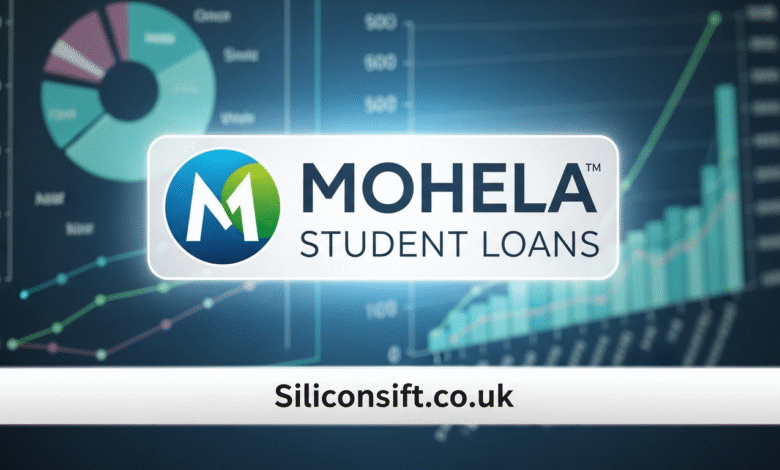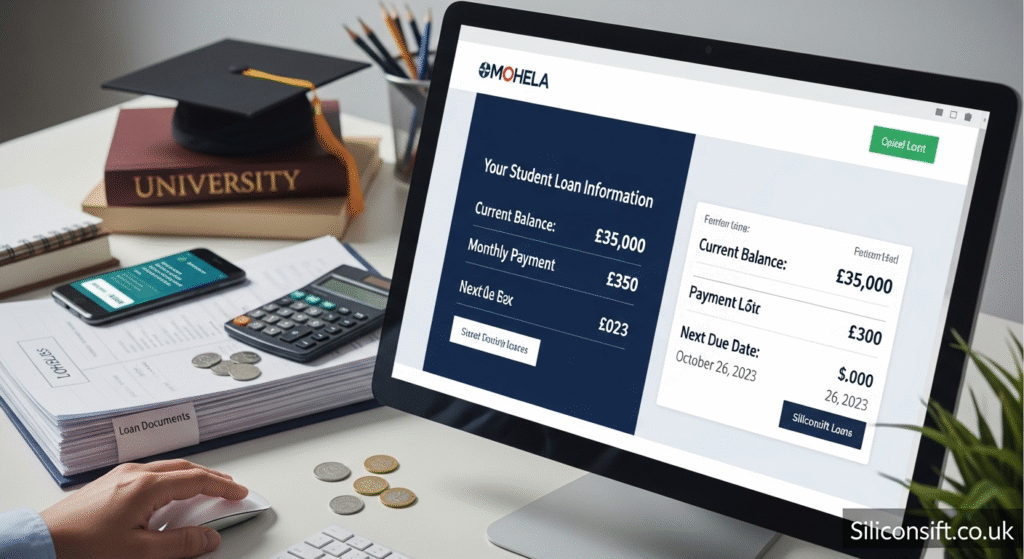MOHELA Student Loans: Essential Truth About Your Federal Repayment

Introduction
If you’ve taken out federal student loans recently, there’s a good chance MOHELA is now part of your life. You might have received an email saying your loans transferred to them, or maybe you’re just trying to figure out who MOHELA even is and why they’re suddenly asking you for money.
Here’s the thing: MOHELA isn’t a lender. They’re a loan servicer, which means they manage your federal student loans on behalf of the Department of Education. Think of them as the middleman who collects your payments, answers your questions, and helps you navigate repayment options.
In this article, I’ll walk you through everything you need to know about MOHELA student loans. You’ll learn what MOHELA does, how to manage your account, what repayment plans are available, and how to tackle common problems. Whether you’re fresh out of school or years into repayment, understanding your servicer makes managing student debt much easier.
Let’s break it down.
What Is MOHELA?
MOHELA stands for Missouri Higher Education Loan Authority. Founded in 1981, it’s a nonprofit organization that serves as one of the largest federal student loan servicers in the United States.
When you borrow federal student loans, the money comes from the U.S. Department of Education. But the government doesn’t handle the day-to-day management of millions of loans. That’s where servicers like MOHELA come in.
MOHELA handles over 8 million borrower accounts. They process payments, update account information, assist with deferment or forbearance requests, and help borrowers apply for income-driven repayment plans and loan forgiveness programs.
Why Your Loans Might Be With MOHELA
You don’t choose your loan servicer. The Department of Education assigns one to you. Your loans might be with MOHELA for several reasons:
- You’re a new borrower, and MOHELA was assigned to service your loans
- Your loans transferred from another servicer (like FedLoan or Navient)
- You’re pursuing Public Service Loan Forgiveness, and MOHELA now exclusively handles PSLF accounts
Since 2022, MOHELA became the sole servicer for borrowers working toward PSLF. If you’re in public service and seeking forgiveness, your loans likely moved to MOHELA automatically.

Types of Federal Student Loans MOHELA Services
MOHELA handles several types of federal student loans. Understanding which loans you have helps you know what repayment options and forgiveness programs you qualify for.
Direct Loans
These are the most common federal student loans. Direct Loans include:
- Direct Subsidized Loans: Available to undergraduate students with financial need. The government pays the interest while you’re in school.
- Direct Unsubsidized Loans: Available to undergraduate and graduate students regardless of financial need. Interest accrues while you’re in school.
- Direct PLUS Loans: Available to graduate students and parents of dependent undergraduates. These have higher interest rates.
- Direct Consolidation Loans: Combine multiple federal loans into one loan with a weighted average interest rate.
FFEL Program Loans
Federal Family Education Loan Program loans were issued before 2010. Some FFEL loans can be serviced by MOHELA, but many borrowers consolidated these into Direct Loans to access better repayment options and forgiveness programs.
Perkins Loans
Perkins Loans were low-interest federal loans for students with exceptional financial need. The program ended in 2017, but MOHELA may service existing Perkins Loans if they were consolidated into Direct Loans.
If you’re unsure what types of loans you have, log into your MOHELA account or check the National Student Loan Data System at StudentAid.gov.
How to Access and Manage Your MOHELA Account
Managing your MOHELA student loans starts with creating and accessing your online account. The online portal is where you’ll make payments, view your balance, update personal information, and apply for repayment plans.
Creating Your Account
Visit MOHELA.com and click on “Register.” You’ll need your Social Security number, date of birth, and account number. MOHELA will verify your identity and send you login credentials.
Once registered, you can access your account dashboard. Here’s what you’ll find:
- Current loan balance and interest rates
- Payment history and upcoming due dates
- Available repayment plans
- Forms for deferment, forbearance, and forgiveness applications
- Contact information to reach customer service
Making Payments
MOHELA offers several payment options:
- Automatic payments: Set up autopay and receive a 0.25% interest rate reduction
- Online payments: Pay directly through your account dashboard
- Phone payments: Call MOHELA’s automated system
- Mail payments: Send checks to the address provided on your billing statement
I always recommend setting up autopay. Not only do you get the interest rate discount, but you’ll never miss a payment. Just make sure you have enough in your account each month.
Mobile App
MOHELA offers a mobile app for iOS and Android. You can check your balance, make payments, and contact customer service from your phone. It’s convenient if you’re always on the go.
Repayment Plans Available Through MOHELA
One of the most important decisions you’ll make is choosing the right repayment plan. MOHELA offers several options, and the best one depends on your income, loan balance, and financial goals.
Standard Repayment Plan
This is the default plan. You pay a fixed amount each month for 10 years. Payments are higher, but you’ll pay less interest over time.
The Standard Plan works well if you can afford the monthly payment and want to get out of debt quickly.
Graduated Repayment Plan
Payments start lower and increase every two years. The repayment term is still 10 years. This plan suits borrowers who expect their income to grow steadily.
Extended Repayment Plan
If you owe more than $30,000 in Direct Loans, you can extend repayment to 25 years. Payments can be fixed or graduated. Monthly payments are lower, but you’ll pay significantly more interest.
Income-Driven Repayment Plans
Income-driven repayment (IDR) plans base your monthly payment on your income and family size. These plans are popular because they make payments more affordable and offer loan forgiveness after 20 or 25 years.
MOHELA administers four IDR plans:
- SAVE Plan (Saving on a Valuable Education): Replaces the REPAYE plan. Payments are based on 5% of discretionary income for undergraduate loans and 10% for graduate loans. Offers the most generous terms.
- PAYE Plan (Pay As You Earn): Caps payments at 10% of discretionary income. Forgiveness after 20 years. You must meet eligibility requirements.
- IBR Plan (Income-Based Repayment): Payments are 10% or 15% of discretionary income, depending on when you borrowed. Forgiveness after 20 or 25 years.
- ICR Plan (Income-Contingent Repayment): Payments are the lesser of 20% of discretionary income or what you’d pay on a fixed 12-year plan. Forgiveness after 25 years.
To apply for an IDR plan, you’ll need to submit an application through MOHELA or StudentAid.gov. You’ll also need to recertify your income and family size annually.
Choosing the Right Plan
If you’re struggling with payments, an IDR plan is usually your best bet. The SAVE Plan offers the lowest payments and most forgiveness benefits. But if you can afford higher payments and want to save on interest, the Standard Plan is better.
MOHELA’s website has a repayment calculator to help you compare plans. You can also call their customer service for personalized guidance.
Public Service Loan Forgiveness and MOHELA
Public Service Loan Forgiveness (PSLF) is a federal program that forgives your remaining loan balance after you make 120 qualifying payments while working full-time for a qualifying employer.
MOHELA is now the exclusive servicer for PSLF. If you’re pursuing forgiveness, your loans will be with MOHELA.
Who Qualifies for PSLF?
To qualify, you must meet these requirements:
- Work full-time for a qualifying employer (government or nonprofit 501(c)(3) organization)
- Have Direct Loans
- Be enrolled in an income-driven repayment plan or the Standard Repayment Plan
- Make 120 qualifying monthly payments
Payments don’t need to be consecutive, but they must be made while employed by a qualifying employer.
How to Apply for PSLF Through MOHELA
First, submit an Employment Certification Form (ECF) annually or whenever you change employers. This form verifies your employment and tracks your qualifying payments.
MOHELA will review your form and update your PSLF payment count. You can check your progress in your MOHELA account.
After making 120 qualifying payments, submit the PSLF Application. MOHELA will review your application and, if approved, the Department of Education will forgive your remaining balance.
Common PSLF Mistakes to Avoid
Many borrowers make mistakes that delay forgiveness. Here are the most common:
- Not submitting ECFs regularly (submit them annually to track your progress)
- Being on the wrong repayment plan (only IDR and Standard Plans qualify)
- Having the wrong loan type (only Direct Loans qualify; consolidate FFEL or Perkins Loans)
- Not working full-time (at least 30 hours per week or your employer’s definition of full-time)
If you’re serious about PSLF, stay organized. Keep copies of your ECFs, track your payment count, and reach out to MOHELA if you have questions.
Teacher Loan Forgiveness
If you teach full-time for five consecutive years at a low-income school, you may qualify for Teacher Loan Forgiveness. This program forgives up to $17,500 of your Direct or FFEL Loans.
MOHELA processes Teacher Loan Forgiveness applications. You’ll need to submit a Teacher Loan Forgiveness Application and have your school certify your employment.
This program is separate from PSLF. If you qualify for both, you’ll need to choose one. PSLF typically offers more forgiveness, but Teacher Loan Forgiveness can be faster if you don’t plan to stay in public service for 10 years.
Deferment and Forbearance Options
Sometimes life happens, and you can’t make your student loan payments. Deferment and forbearance are temporary solutions that pause or reduce your payments.
Deferment
During deferment, you don’t have to make payments. Interest doesn’t accrue on subsidized loans but does accrue on unsubsidized loans.
Common deferment reasons include:
- Enrollment in school at least half-time
- Unemployment
- Economic hardship
- Military service
- Cancer treatment
To request deferment, log into your MOHELA account and submit the appropriate form.
Forbearance
Forbearance also pauses your payments, but interest accrues on all loans. You can request forbearance for financial hardship, medical expenses, or other reasons.
General forbearance is granted at MOHELA’s discretion. Mandatory forbearance must be granted if you meet specific criteria, like serving in a medical or dental internship.
When to Use Deferment or Forbearance
These options should be temporary. Interest can pile up quickly, increasing your overall debt. If you’re struggling long-term, consider switching to an income-driven repayment plan instead. Your payment might be as low as $0 based on your income, and that time still counts toward forgiveness.
Common Problems and How to Solve Them
Dealing with student loans can be frustrating. Here are some common issues MOHELA borrowers face and how to handle them.
Payment Processing Delays
Some borrowers report payments not showing up on time. If this happens, keep records of all payments. Contact MOHELA with proof of payment, like a bank statement or confirmation number.
Trouble Reaching Customer Service
MOHELA’s call volume can be high. Wait times are often long. Try calling early in the morning or late in the afternoon. You can also message them through your online account or use the mobile app.
Loan Transfer Confusion
When your loans transfer to MOHELA from another servicer, there can be confusion about payment amounts or due dates. Review your account carefully when you first transfer. If something looks wrong, contact MOHELA immediately.
PSLF Payment Count Errors
Some borrowers find their PSLF payment count doesn’t match what they expected. Submit ECFs regularly to avoid this. If you notice an error, contact MOHELA and provide documentation of your employment and payments.
Interest Capitalization Concerns
When unpaid interest gets added to your principal balance, it’s called capitalization. This increases what you owe and means you’ll pay interest on interest. Capitalization happens when you leave certain repayment plans or forbearance.
To minimize capitalization, avoid forbearance when possible. Use deferment or income-driven repayment instead.

Tips for Paying Off MOHELA Student Loans Faster
If you want to get out of debt sooner, here are some strategies:
Make Extra Payments
Any extra payment goes toward principal (after covering interest), reducing your balance faster. Even an extra $50 a month makes a difference.
When making extra payments, specify that you want the payment applied to principal. Contact MOHELA to ensure they process it correctly.
Refinance (But Be Careful)
Refinancing means taking out a private loan to pay off your federal loans. You might get a lower interest rate, saving money.
But refinancing federal loans into private loans means losing federal benefits. You’ll no longer qualify for income-driven repayment, PSLF, or federal deferment options. Only refinance if you don’t need these protections and can get a significantly lower rate.
Use Windfalls Wisely
Tax refunds, bonuses, or gifts can be used to make lump-sum payments. Applying these to your principal reduces your balance and interest.
Avoid Default
Defaulting on federal student loans has serious consequences. Your wages can be garnished, your tax refunds seized, and your credit score damaged. If you’re struggling, contact MOHELA immediately. They can help you switch repayment plans or apply for deferment.
MOHELA Customer Service and Support
MOHELA offers several ways to get help:
- Phone: 1-888-866-4352 (Monday through Friday, 8 a.m. to 8 p.m. Central Time)
- Online messaging: Through your MOHELA account
- Mail: MOHELA, 633 Spirit Drive, Chesterfield, MO 63005-1243
- Social media: MOHELA has a presence on Twitter and Facebook for general inquiries
If you’re not getting the help you need from MOHELA, you can contact the Federal Student Aid Ombudsman. They help resolve disputes between borrowers and loan servicers.
Staying Informed About Changes
Student loan policies change frequently. New repayment plans, forgiveness programs, and servicer updates can impact your loans.
To stay informed:
- Check your email regularly. MOHELA sends important updates about your account.
- Visit StudentAid.gov for federal student loan news.
- Follow reliable sources like the Consumer Financial Protection Bureau (CFPB) or National Consumer Law Center.
- Log into your MOHELA account monthly to review your balance and payment status.
Being proactive helps you take advantage of new benefits and avoid missed opportunities.
Conclusion
MOHELA student loans can feel complicated, but understanding how your servicer works puts you in control. Whether you’re navigating repayment plans, pursuing PSLF, or simply trying to stay on top of monthly payments, knowing your options is the first step.
Choose the right repayment plan for your situation. If you’re in public service, track your PSLF progress carefully. If you’re struggling, reach out for help before falling behind. And if you can afford extra payments, chip away at that principal.
You’ve got this. Managing student loans takes effort, but with the right knowledge and a solid plan, you can pay off your debt and move forward with confidence.
What’s your biggest challenge with MOHELA student loans? Have you had success with a particular repayment plan or forgiveness program? Share your experience or questions in the comments below.
Frequently Asked Questions
1. What is MOHELA, and why is it servicing my federal student loans?
MOHELA is a nonprofit loan servicer that manages federal student loans on behalf of the U.S. Department of Education. You were assigned to MOHELA by the government. They handle your payments, account management, and assist with repayment plans and forgiveness programs.
2. How do I make a payment to MOHELA?
You can make payments online through your MOHELA account, by phone using their automated system, by mail, or by setting up automatic payments. Autopay saves you 0.25% on your interest rate, so it’s a smart choice if you can manage it.
3. Can I choose a different loan servicer instead of MOHELA?
No, you cannot choose your federal loan servicer. The Department of Education assigns servicers. However, if you refinance your federal loans with a private lender, you’ll work with that lender instead. Keep in mind that refinancing means losing federal benefits.
4. How long does it take for MOHELA to process a payment?
Electronic payments typically process within one to three business days. Mailed payments can take up to 10 days to process. Always make payments before your due date to avoid late fees or negative credit reporting.
5. What should I do if I can’t afford my monthly payment?
Contact MOHELA immediately. You can apply for an income-driven repayment plan to lower your payment based on your income. You can also request deferment or forbearance if you qualify. Don’t ignore the problem, as defaulting has serious consequences.
6. How do I check my PSLF payment count with MOHELA?
Log into your MOHELA account and navigate to the PSLF section. Your qualifying payment count will be displayed. Make sure to submit Employment Certification Forms regularly to keep your count updated.
7. Will MOHELA report my payments to credit bureaus?
Yes, MOHELA reports your payment history to the three major credit bureaus. Making on-time payments helps build your credit score. Missing payments or defaulting will hurt your credit.
8. Can I pay off my MOHELA student loans early without penalty?
Yes, federal student loans have no prepayment penalties. You can pay extra or pay off your entire balance early without any fees. Just make sure to specify that extra payments should go toward principal.
9. What happens if MOHELA makes an error on my account?
Contact MOHELA immediately with documentation to support your claim. If they don’t resolve the issue, you can escalate it to the Federal Student Aid Ombudsman, who helps resolve disputes between borrowers and servicers.
10. How do I transfer my loans from MOHELA to another servicer?
You cannot request a transfer. The Department of Education decides loan servicer assignments. Transfers happen when servicers lose contracts or when you consolidate your loans. If your loans transfer, you’ll receive notification from both your old and new servicer.
Also Read Siliconsift.co.uk